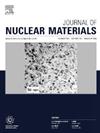用于 MYRRHA 的液态铅铋共晶中氧化镍的热力学稳定性和成核的实验评估
IF 2.8
2区 工程技术
Q3 MATERIALS SCIENCE, MULTIDISCIPLINARY
引用次数: 0
摘要
MYRRHA 是一个加速器驱动系统,其主冷却剂为液态铅铋共晶(LBE)。镍是铅铋共晶液在正常运行期间释放的主要腐蚀产物,有可能与铋形成氧化物和金属间化合物。我们首先测量了 225 至 500 °C 三种镍浓度水平下镍氧化物平衡时的溶解氧浓度 (DOC)。这些测量结果显示与文献中预期的趋势存在偏差,尤其是在 325-400 °C 的范围内。根据测量结果,我们提出了该温度范围内镍在 LBE 中的活性系数。其次,我们通过循环改变高镍浓度和不同 DOC 水平下的 LBE 温度,确定了 NiO 成核的条件。根据这些观察结果,我们得出结论:在 MYRRHA 工作条件(200-400 °C,10-7-10-6 wt.%)下,不可能出现氧化镍成核现象。本文章由计算机程序翻译,如有差异,请以英文原文为准。
Experimental assessment of thermodynamic stability and nucleation of NiO in liquid lead-bismuth eutectic for MYRRHA
MYRRHA is an accelerator-driven system with a primary coolant of liquid lead-bismuth eutectic (LBE). Nickel, a major corrosion product released in LBE during normal operation, can potentially form oxides and intermetallic compounds with bismuth. This study focuses on the behavior of dissolved nickel and the conditions for nickel oxide (NiO) formation in LBE.
We first measured the dissolved oxygen concentration (DOC) at the NiO equilibrium from 225 to 500 °C across three levels of nickel concentration. These measurements showed a deviation from the trend expected from literature, particularly in the range of 325–400 °C. Based on the measurements, we proposed the activity coefficient of Ni in LBE within this temperature range. Secondly, we identified the conditions for NiO nucleation by cyclically varying the temperature of LBE at high nickel concentration and different DOC levels. Based on these observations, we concluded that NiO nucleation is unlikely under the MYRRHA operating conditions (200–400 °C, 10–7–10–6 wt.%).
求助全文
通过发布文献求助,成功后即可免费获取论文全文。
去求助
来源期刊

Journal of Nuclear Materials
工程技术-材料科学:综合
CiteScore
5.70
自引率
25.80%
发文量
601
审稿时长
63 days
期刊介绍:
The Journal of Nuclear Materials publishes high quality papers in materials research for nuclear applications, primarily fission reactors, fusion reactors, and similar environments including radiation areas of charged particle accelerators. Both original research and critical review papers covering experimental, theoretical, and computational aspects of either fundamental or applied nature are welcome.
The breadth of the field is such that a wide range of processes and properties in the field of materials science and engineering is of interest to the readership, spanning atom-scale processes, microstructures, thermodynamics, mechanical properties, physical properties, and corrosion, for example.
Topics covered by JNM
Fission reactor materials, including fuels, cladding, core structures, pressure vessels, coolant interactions with materials, moderator and control components, fission product behavior.
Materials aspects of the entire fuel cycle.
Materials aspects of the actinides and their compounds.
Performance of nuclear waste materials; materials aspects of the immobilization of wastes.
Fusion reactor materials, including first walls, blankets, insulators and magnets.
Neutron and charged particle radiation effects in materials, including defects, transmutations, microstructures, phase changes and macroscopic properties.
Interaction of plasmas, ion beams, electron beams and electromagnetic radiation with materials relevant to nuclear systems.
 求助内容:
求助内容: 应助结果提醒方式:
应助结果提醒方式:


